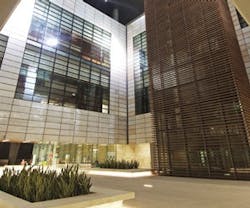King Abdullah University of Science and Technology
In addition to notching the No. 1 ranking in Interiors & Sources' annual Top 10 LEED, the world's largest LEED Platinum project is, according to the American Institute of Architects (AIA), also one of the best examples of sustainable design in 2010.
King Abdullah University of Science and Technology (KAUST), designed by global A&D firm HOK, has been selected as one of the 2010 "Top Ten Green Projects" by AIA's Committee on the Environment. The annual awards program honors sustainable projects resulting from an integrated approach to architecture, natural systems and technology.
As Saudi Arabia's first LEED-certified project, KAUST is a new international, graduate-level research university established to drive innovation in science and technology, and to support world-class research in areas such as energy and the environment.
HOK designed the 6.5-million-square-foot campus on a highly visible 9,000-acre site along the Red Sea, 50 miles north of Jeddah.
Multiple HOK design teams from around the world worked in tandem to integrate sustainability into the design and construction of this world-class, 26-building campus. Several hundred HOK personnel in 11 different offices on three continents contributed to the ambitious project, which was delivered within an unprecedented schedule—from conception to completion in just three years.
The project team integrated a series of innovative strategies to create a low-energy, highly sustainable project in the context of an extremely hot and humid climate.
The project delivers exceptional performance in the areas of water (100 percent wastewater reuse, 42 percent water reduction); energy (27.1 percent annual energy cost savings, 7.8 percent on-site renewable energy, 80 percent of glazing shaded year-round); and materials (20 percent recycled content, 38 percent regional materials, 99 percent wood from Forest Stewardship Council sources, 80 percent construction waste management).
"Because the research and development of renewable resources drives KAUST's research agenda, sustainable development is integral to its overall mission," says Bill Odell, FAIA, HOK design principal. "By integrating sustainable measures into the site planning, community, building design and campus operations, the university is demonstrating new ways to build in the region and promoting responsible stewardship of the environment."
